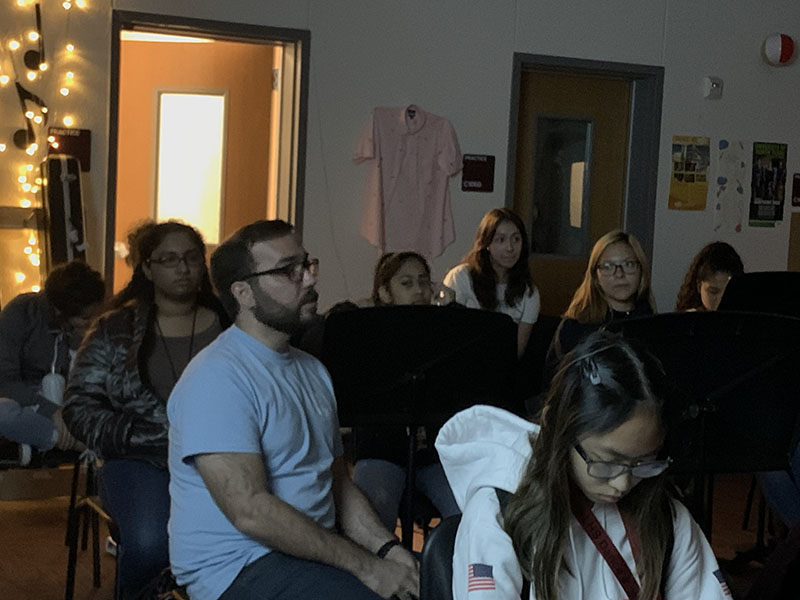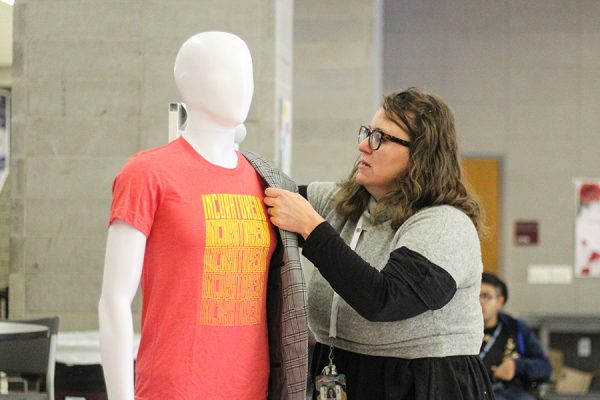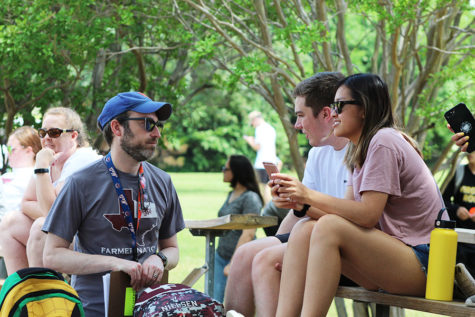Taking care
Suicide prevention lesson took place during advisory on Monday, Nov. 11
Orchestra director James Zauner talks to students during the suicide prevention lesson on Monday, Nov. 11.
In the world people live in today, the topic of mental health has made its way to the forefront of discussions. Not just that, but as time goes on, there is an increasing demand for awareness. The concept of mental health has existed since the beginning of time, but for too long it has been hidden in a corner. The issue has always been deemed uncomfortable, due to its sensitive and vulnerable nature.
Schools have taken action in terms of addressing the growing demands for conversations about mental health. Specifically though, schools look to bring teens and administrators awareness and education on matters of suicide and seeking help.
The state of Texas is required to teach curriculum that touches the topic of mental health and suicide. For this reason, the counselors presented an updated suicide prevention lesson on Monday, Nov. 11 during advisory.
Counselor Dianna Alagood believes high school students are faced with intense pressure in their teens due to the fact that they are young and trying to navigate their way through school and general life whilst planning for their futures. These factors all make suicide prevention an urgent topic of conversation.
“I think there’s a lot more stress,” Alagood said. “Students are having to deal with their personal life, they’re having to worry about getting into the college [scene], which is extremely competitive now. [This is] just a different world that we live in.”
In addition to efforts by the school counselors, the student body is turning its attention to mental health. Specifically, students like senior StuCo project officer Semi Ojerinde seek ways to use the influence they have to further normalize discussions about mental health.
“I think it starts off with admitting that you’re going through something,” Ojerinde said. “Once you admit and you really tell someone ‘Hey, I’m really going through this,’ it’s very helpful.”
Gina Moore, a licensed specialist in school psychology, believes there’s still plenty of work to be done in terms of easing the way that topics of suicide and mental health are talked about.
Why don’t we as [a] society look at going to the counselor like going to the doctor or the dentist?
— counselor Dianna Alagood
“There is still a significant stigma related to mental health,” Moore said. “[It] prevents individuals from recognizing when there is a problem and not seeking assistance when needed.”
Aside from the state-mandated lesson, the administration makes its best effort every day to change the negative inflection frequently accompanies this topic. Alagood hopes to achieve this sense of normalcy by viewing mental illness as one would view any other kind of pain.
“We go to the doctor, we go to the dentist, we do other things to help ourselves physically,” Alagood said. “Why don’t we as [a] society look at going to the counselor like going to the doctor or the dentist?”
A teenager herself, Ojerinde believes that sometimes an adolescent’s issues may be taken too lightly. When teens make choices to open up to adults, they hope to be welcomed with understanding and sympathy. Sometimes what they receive is the opposite, making it discouraging and creating a barrier for those troubled teens seeking of help.
“Kids and teenagers, our feelings are very downplayed nowadays,” Ojerinde said. “If you feel this way, an adult will be like ‘Oh it’s OK. I have five jobs and a cat and I have to pay my bills, so your emotions are invalid.’ It makes us feel as if we can’t really talk about it. Having those pressures and also things from high school and college and everything, it feels as if our opinion is invalid.”
Moore believes the underlying issue in truly conveying the message of awareness and prevention is the lack of knowledge, both for individuals who seek help and those who surround them. She believes to truly erase the stigma, the community must come together.
“I would say there is a need for dialogue and education for all individuals,” Moore said. “I think that awareness about maintaining a healthy emotional-life balance and knowing what resources are available, when needed, is imperative for all members of the community.”
We seek help when we are struggling with our emotions. It’s OK to not be OK.
— school psychologist Gina Moore
Though the nature of the topic is somber, it is crucial that schools direct lessons on suicide prevention. For this reason, the administration requires a great deal of preparation and knowledge about mental health. Faculty across the district underwent special training before the beginning of the school year.
“There is a great deal [of] information on mental health during our work days before school starts,” Alagood said. “[This helps] teachers [better] themselves and [improve] the way they work with students. Of course, we’re always available. We actually have a session that all of the staff, teachers and everyone has to do on mental health and it’s quite comprehensive, and we have to do that and get certified.”
The overarching message counselors and administration hope to get across with this lesson is the importance of self-care. They hope that it gives struggling teens a sense of understanding, normality and encouragement to look for resources when they are needed.
“If we are feeling ill or become injured we seek care,” Moore said. “We exercise and watch our diet to preserve our health. The same applies to our emotional well-being. We engage in self-care, mindfulness or other strategies to safeguard ourselves from life’s stresses. We seek help when we are struggling with our emotions. It’s OK to not be OK.”

















